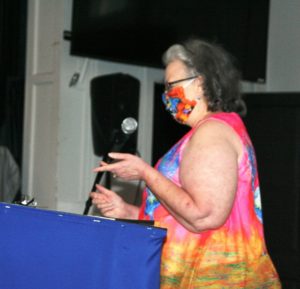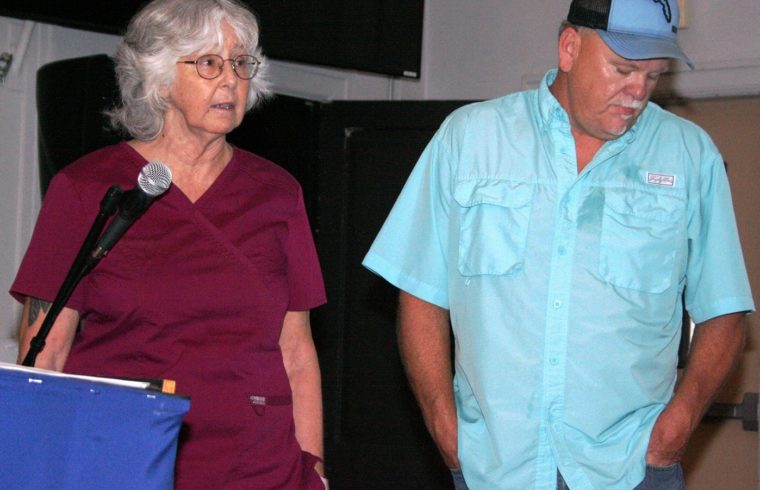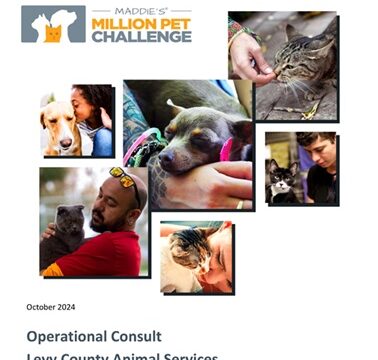Dr. Darlene Esler, veterinarian for Levy County Animal Services and David Weatherford, director of Levy County Animal Services respond to questions at a workshop on the new animal control ordinance.
By Terry Witt – Spotlight Senior Reporter
For those of you who are nerdy types and love to curl up at night with a long legal document full of definitions and requirements that only lawyers really understand, Levy County’s new animal control ordinance is right up your alley.
The 39-page ordinance is related to two other ordinances, one dealing with aggressive dogs and the other listing fines. The three ordinances combined are about 54 pages long and detail how the county will control your dogs and cats.
The new law covers only unincorporated sections of the county, but because cities bring unwanted dogs and cats to Levy County Animal Services, cities are mentioned in the ordinance. Cities must pay to leave animals at the county pound.
While the main ordinance itself is probably long overdue, according to the Levy County Commission, it isn’t light reading by any means and it brought many questions at a commission workshop on Oct. 20.
Final Approval Phase
County Attorney Anne Bast Brown said she would work up a final copy of the ordinance including any minor changes that came from the workshop and give it to County Judge James T. Browning for his review.
A copy of the ordinance will go to the State Attorney’s office, which prosecutes misdemeanor and felony animal abuse and neglect crimes. County commissioners also will receive their copy.
The main ordinance is geared to civil citations for violators of the ordinance but the Levy County Sheriff’s Office can be called by the animal services director to investigate abuse or neglect cases.
Two public hearings must be held before the three ordinances become law. It is probably a good idea for residents to read these proposed ordinances and figure out how it may affect you and your animals.
The main ordinance contains more than 40 definitions.
One definition talks about the need for animals to have valid identification. The ordinance defines valid identification as any form of identification found on an animal that provides current owner contact information. It doesn’t pin down what specific types of identification are acceptable, but one would assume microchips or tags and collars would pass muster.
Microchips aren’t mandatory except for impounded animals when they are being released to their owner or some other person claiming the animal. The owner must show proof of ownership to claim their animal. If someone is picking up the animal for the owner they must show proof they are authorized to do so.
Discussing Mandatory Microchips
Commissioners were opposed to a request from Bob Levesque, president of Levy Animal Friends, Inc., to establish a mandatory microchip program of some sort in Levy County.
“While we understand that we cannot manage a mandatory licensing program for Levy County and we realize the leash law is not necessarily appropriate in the unincorporated part of the county, we feverishly request a mandatory microchipping program of some kind,” Levesque wrote in a letter. “We recognize that we are a very rural community and have many low and fixed income owners, but the number of lost and unidentified dogs and cats throughout the county is very high. This puts tremendous pressure on rescue organizations to pull these animals to evade euthanasia. To ignore the one program that can help re-home pets and/or identify a neglectful owner is appalling and apprehensive to rescue people who make every attempt to serve our county and citizens of our county who are then obligated to assist these animals in so many ways.”
Commissioner John Meeks said mandatory microchipping just won’t work. “How do you enforce that? Are you going to send someone out to see if everyone’s dog has a microchip? If it doesn’t, what happens, do I get fined, do they take away my dogs? I feel we could get a good deal on microchips. We could do something on a weekend; microchip your dog for $10. Then we know we’ve done it,” Meeks said. “I think there has been a desperate need for some changes to this (ordinance) for a while to address the problems we’ve had. Our county is growing. We have people moving in; people want things done in a different way. There comes a point where, how much government do we need in our lives.”
Commissioner Rock Meeks said microchipping is a good idea if it’s voluntary.
“I would rather if you want something mandatory – make it so the animals have a collar and an ID tag with a number you can get hold of the dog owner or cat owner,” Meeks said. “At the end of the day, I have 20 head of deer dogs. Is that going to require me to microchip all 20 of them? I have dogs. I take care of them all very well, much better than most and probably better than some people do their young’uns, but I don’t carry them to vet all the time either because they don’t require me calling the vet. As far as, do I believe all should have a microchip, I don’t think so personally,” Meeks said.
Less Power for Director
Levesque also asked the county to eliminate the portion of the main ordinance that gives the animal services director the power to overturn or dismiss a violation of the ordinance issued by one of his animal control officers.
“Having been trained and certified, sometimes greater than the director, an officer authorized to issue a citation should not have it dismissed by the director,” Levesque wrote in his letter. “In some known cases, a director may behave in a manner that shows favoritism, inequality or simply be viewed as doing favors outside the definitions of these ordinances. Instead, the county has appointed a citizen appeal board to hear aggressive animal cases; this board can review these appeals. At that time, the director can speak to the board on behalf of the violator if he/she feels strongly about the details of the offense.”
Commissioners didn’t discuss the suggestion by Levesque, but read it into the record.
Giving Cats a Break
Lou Jones, retired editor of the Chiefland Citizen, took issue with an ordinance requirement for mandatory spay and neutering of cats that are four months or older unless the animal is certified to compete in shows, a veterinarian certifies the animal is unfit to undergo the surgery or the cat is used for breeding purposes.

Jones said she doesn’t object to spaying or neutering cats. Both of her cats, Miss Midnight and Scooter are spayed and neutered and every animal she has ever owned has been sterilized, but she said she didn’t think it was fair to enforce mandatory spray and neutering of cats and no other animals.
“I think cats are getting a bad deal in this. I understand the county gets overrun with cats, and they can’t handle them and kittens,” she said. “I think a good TNR (trap, neuter and release) program would help. I’ve never had my garbage attacked by a cat but for months at a time I’ve had a dog come over and visit because he liked to attack the garbage.”
Dr. Darlene Esler, veterinarian for Levy County Animal Services, said the county already has a TNR program that services about 18 cats per month. The county offers residents cages to trap the feral cats. Once they are in the trap, the cats are taken by the resident to animal services to be spayed or neutered before being returned to the same neighborhood.
The ordinance also prohibits any person who owns, harbors, or keeps an “outdoor cat” that hasn’t been spayed or neutered, which is three months of age or older, outdoors.
“I’m bothered by the portion that requires that a cat must be spayed or neutered within three months. I find it horrendous that dogs aren’t, or that people’s pet pigs would not be,” said Jones.
Jones acknowledged that many cat owners abandon their cats in Levy County as though the county was a dumping site, and feral cats are a problem, but she feels the ordinance should treat dogs and cats more even-handedly.
Animal Services Director David Weatherford said the county has a big problem with feral cats. He said a female can breed and produce a litter three times a year. He said the county added a section requiring spay and neutering of outdoor cats three months of age to cut down on the number of feral cats in the county and reduce the number of cats being euthanized.
Abuser Registry
The ordinance also establishes an animal abuser registry containing the names of convicted animal abuse offenders in the unincorporated portions of the county.
“When a person is convicted of an animal abuse offense in the unincorporated areas of the county, the prosecuting agency shall forward to the Levy County Sheriff’s Office and to the maintaining agency the name and address of the convicted person along with the name of the animal abuse offense the person was convicted of, thereby notifying the sheriff’s office and the maintaining agency that the person is required to be placed on the animal abuse registry. The role of the sheriff’s office is to photograph the offender and to obtain and record the following information and to transmit such information to the maintaining agency for inclusion in the animal abuser registry,” the ordinance says.
The information on the registry shall include the following information:
- Their name and any aliases or other legal names they used or have been known by;
- Their residence address;
- Their date of birth;
- A photograph of the front of their head and shoulders not less than two inches by three inches;
- A written description of any visible tattoos on the face, neck, or arms of the animal abuse offender.
Irresponsible Pet Owner
A person will be designated as an irresponsible pet owner upon being found guilty more than once in a three year period of any combination of the following:
- Owning a dog that while under the person’s ownership, custody or control, is declared aggressive or dangerous as a result of an investigation by the director.
- Owning a dog that while under the person’s ownership, custody or control commits an attack that causes severe injury or death to another human being or, owning a dog that has previously been declared dangerous and that while under the person’s ownership, custody or control commits other attacks.
For a period of three years from the date of designation an irresponsible pet owner must comply with the following requirements:
- Any animals owned by the person must be microchipped within 30 days of the date of designation as an irresponsible pet owner.
- The irresponsible pet owner may not acquire, own, keep, control, or harbor domestic animals, beyond those that the person owns, keep, control or harbors at the time of designation.
- Animal Services will establish and maintain an irresponsible pet owner registry consisting of individuals designated as irresponsible pet owners as well as animals owned by the individual.
Dangerous Dog Classification or Destruction
Animal Services will investigate reported incidents involving a dog that may be dangerous and if possible shall interview the owner and require a sworn affidavit from any person, including any animal control officer or law enforcement officer desiring to have a dog classified as dangerous.
After the investigation, the director shall make an initial determination as to whether there is sufficient cause to classify the dog as dangerous and determine the penalty.
The department must afford the owner an opportunity for a hearing prior to making a final determination regarding the classification or the penalty. The director shall notify the owner by registered mail, certified mail, certified hand delivery within seven days of the finding, and proposed penalty. If the owner files an appeal the dog must be held and may not be destroyed while the appeal is pending.
If the owner does not request a hearing or the Animal Services Committee upholds the initial determination of the director, the dog shall be classified as a dangerous dog and a penalty imposed. The county shall provide a written final order to the owner by registered mail, certified mail, certified hand deliver, or service. The owner may appeal the classification, penalty, or both in circuit court after receiving the final order.
A dog may NOT be declared dangerous if:
- The threat, injury or damage was sustained by a person who, at the time, was unlawfully on the property or who, while lawfully on the property, was tormenting, abusing or assaulting the dog or its owner or a family member.
- The dog was protecting or defending a human being within immediate vicinity of the dog from an unjustified attack or assault.
- Hunting dogs are exempt from this section when engaged in a legal hunt or training procedure. Dogs engaged in training or exhibiting in legal sports such as obedience trials, conformation shows, field shows, hunting/retrieving trials and herding trials are exempt from this section when engaged in any legal procedures. However, such dogs at all other times in all other respects are subject to this second. Dogs that are classified as dangerous may not be used for hunting purposes. Any dog that is owned, or the service of which is employed by a law enforcement agency is exempt from this section.
This story hits on a few of the main points in the ordinance discussed at the county commission workshop but by no means includes all of the information in the three ordinances that make up the proposed laws governing cats and dogs in the unincorporated areas of the county.
—————–
Board of County Commission Animal Control Workshop October 20, 2020; Posted October 24, 2020













